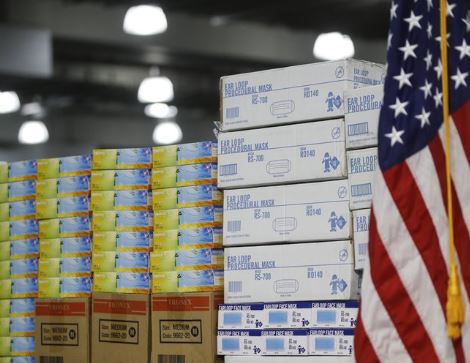
(Photo: AP)
Washington (People’s Daily) -- Confirmed infections in the US were more than double that of any other nation, at nearly 387,000, according to data Tuesday from Johns Hopkins University. Deaths from the COVID-19 respiratory disease caused by the virus rose to more than 12,000 among Americans, while 20,191 have recovered.
According to projections by the US government, the United States was already on course to see more of its people die than in the wars of Korea, Vietnam, Afghanistan and Iraq combined.
The country has adopted an array of wartime measures never before collectively employed in US history — banning incoming travelers from two continents, bringing commerce to a near-halt, enlisting industry to make emergency medical gear, and confining 230 million Americans to their homes in a desperate bid to survive an attack by an unseen adversary.
The Washington Post commented that, despite these and other extreme steps, the United States will likely go down as the country that was supposedly best prepared to fight a pandemic but ended up catastrophically overmatched by the novel coronavirus, sustaining heavier casualties than any other nation.
Under the spread of COVID-19, intensive care units in various American states were full and governors sought help from the federal government in hopes of obtaining more ventilators and protective equipment. In order to solve the problem of a shortage of protective materials, hospitals had to find ways to reuse the mask, including attaching a protective film on the outside of the N95 mask.
The New York Times said that this is a chaotic situation. In the face of such a serious public health threat, the United States has no unified response plan, each state is independent, and the federal government has repeatedly issued contradictory information.
The US media has repeatedly disclosed the government ’s mistakes in responding to the epidemic, such as the failure to conduct large-scale testing of the population in the early stages of the epidemic, blame between different agencies, and the White House’s understatement of the crisis.
The former director of the US Centers for Disease Control and Prevention Dr Thomas Frieden said that strict screening was not carried out until "it was too late," which was a mistake in the government's response. The former Director of the US Food and Drug Administration (FDA), Dr Margaret Hamburger, said the error caused "cases to grow exponentially."
The New York Times recently published a long newsletter detailing how the US government has turned a blind eye to the New Crown Epidemic Crisis since January, which ultimately led to the outbreak of the pandemic in the United States. It was reported that when COVID-19 first appeared in January, White House officials only focused their attention on how to evacuate Americans from Wuhan, and issued a travel ban on China, underestimating the risk of a local outbreak of community transmission.
Although public health experts have repeatedly called for strengthening local screening, the virus detection kits developed in the United States have encountered technical problems and took three weeks to resolve. The FDA's cumbersome approval process also makes it difficult for private clinics and laboratories to carry out new coronavirus testing.
In mid-February, the United States had a daily detection capacity of only 100 cases, which is far from other countries. To date, there have been more than 300,000 confirmed cases in the US, but there are still many Americans with suspected symptoms who cannot be tested.
According to the Washington Post eport, states and hospitals in the United States have tried their best to compete for rare medical equipment and materials and have almost fallen into chaos. Arkansas Governor Asa Hutchinson said that many states originally wanted the federal government to play a leading role in ensuring the supply of medical supplies such as masks and protective clothing. This is not the case.
"The federal government requires all states to solve their own material problems. The federal government only provides 25 percent of the materials needed in Arkansas from the national strategic reserve. It requires brutal competition among the 50 states to obtain necessary medical equipment and materials."
In addition, the timeliness of the implementation of US prevention and control measures has affected the effectiveness of epidemic prevention and control to a certain extent. The White House declared a "state of emergency" on March 13, and many state governments announced "stay at home” orders to reduce the risk of community transmission.
However, due to the different intensity of pandemic prevention measures formulated by different states in the US and the public's dissatisfaction with the government's inadequate early response, it is difficult to say whether the relevant epidemic prevention measures can be implemented in place.
"If the US government had carried out extensive virus detection earlier, improved the medical monitoring system, started preparations for hospitals, hospital beds, and emergency production of protective equipment such as masks and ventilators, we would not be in such a difficult situation today," said Jeffrey Levy, a professor at the Department of Health Policy and Management at George Washington University.
“The coronavirus may be the first crisis Trump has faced in office where the facts — the thousands of mounting deaths and infections — are so devastatingly evident that they defy these tactics,” the Washington Post reported, after months of dismissing the severity of the coronavirus, resisting calls for austere measures to contain it, and recasting himself as a wartime president, Trump seemed finally to succumb to the coronavirus reality.
In a meeting with a Republican ally in the Oval Office last month, the president said his campaign no longer mattered because his re-election would hinge on his coronavirus response.


